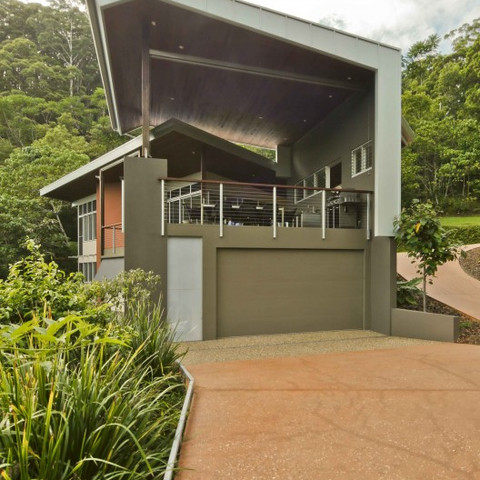A beautiful and sustainable house adjoining Springbrook National Park
- Mark Walsh

- Feb 10, 2015
- 7 min read

A disused banana farm overrun by noxoius weeds, on the fringes of a world heritage
national park, provided the perfect clean slate for sustainable design. Acquired by a couple
with strong environmental values, the Austinville project was part of a larger strategy for
them to give back to the environment. With a long history in the region, the lot has a diversity
of forest types, a creek and breathtaking views of the valley. The owners have embarked on
an enormous project to regenerate the land. As part of this process the property was
registered with the State Government as a Nature Refuge, which is essentially a private
National Park.
The beginnings of a building strategy had been founded and a future house would need to embrace the sustainable philosophies built into the lifestyles of the owners. They wanted a simple home with an aesthetic that communicated the spirit of the land regeneration and the owners sustainable lifestyle. At its core, sustainable living is structured to minimize our footprints on the natural ecology – at both a micro and macro scale.

A multitude of environmentally sustainable concepts were considered and included the impacts on the environment by living on ecologically sensitive land, energy consumption, re-use of waste and actually living in and with the natural environment. For instance the builder found 14 brown tree snakes living in the roof of the original structure. The sustainable concepts identified were encompassed by a single word – simplicity, and this drove the entire design and building ethos. An elaborate and complex house with its associated automation and sophisticated electrical appliances was not on the agenda.
Rather a small functional house that cleverly adapted to its environment and its users was preferred. The design philosophy embraced an aesthetic philosophy with its roots in the forms of old banana sheds and National Park structures.
The selected site location for the future retirement dwelling was an existing building situated on the top of a ridge overlooking the valley to the north. The initial intent was to refurbish the existing dwelling and create a large outdoor living area that was useable in both summer and winter months. An extensive design and ongoing design collaboration with client, architect and builder developed a design solution to encompass the living needs of a modern family within the restraints of a much smaller footprint than typically would be the case.
At the commencement of construction, it became apparent that the existing structure posed some significant challenges, namely that the foundations the house was built on were potentially inadequate. Termite proofing would also prove problematic due to the way the original structure had been built. Extensive discussions and analysis led to the conclusion that the original footings would not support the long lifecycle required of the refurbishment. The existing dwelling was demolished to make way for a new structure.
The architect advised that the design for the refurbishment of the old dwelling had already achieved an optimum solution for both the site and the needs of the users and there was no need to develop a new design. The only change made was an increase in the ceiling heights.
Springbrook has a relatively extreme climate ranging from hot summer months to cool winter months. Shading, sunlight and the retention of heat would be critical. The main outdoor living area would need to maximize the use of shade in summer and benefit from direct sun in winter. The internal living areas would need to be open to sun in winter, and to also retain heat and allow it to reradiate in the cool nights. Summer days would require cross flow ventilation controlled by manually adjustable louvres. The prevention of bird collisions into the glass was a priority. While some adhesive devices were available, louvres became the most viable option due to their visibility to birds and their versatility in controlling weather conditions.
The design of the deck roof was principally driven by sun angles and the designers provided twelve hour modeling of the sun paths and sun shading for the deck, and indeed the entire dwelling for various days during the year. Small movies were made and posted on u-tube for all to see and analyse. The design also incorporated the seamless inclusion of shade blinds that could be used to exclude winter sun if necessary.
Springbrook is one of the wettest places in Queensland driving a need to create a living area that could cope with long periods of rain. The deck was a key element of this but there was also a requirement to be able to walk around the house without getting wet. Extra large eaves, requiring innovative engineering design, were made to fit elegantly within the overall lines of the building.

A modification of the traditional Arabic solar chimney was used in the living area. The masonry structure, dense and heat retentive, stores winter heat from the sun, and re-radiates it at night when the air temperature is cooler. Similarly the solar chimney, housing a modern day wood heater, utilizes the masonry structure to store the heat generated by the fire. During the summer months, the masonry is shaded by the roof overhangs. Vents are opened at both the top and bottom of the chimney. As the portion of the wall facing the daylight heats, the hot air rises and creates breeze through the chimney. The breeze cools the internal facing wall. The cooler wall then absorbs heat from the internal living space and provides a passive cooling device to the interior of the house.
The construction challenges of such a project were enormous, as access for delivery of materials was difficult, there was no grid power, communication networks remain limited, site access was periodically waterlogged, snakes prevailed, and a steep incline and clay soil which proved difficult in wet weather were just a few of the many difficulties encountered.
The house is completely self sufficient in electricity. A dedicated battery room was designed as a key element of the house. Excess daytime energy is stored in the batteries for use at night and during overcast days. Because of the unobstructed northerly aspect of the house and low electricity requirements only ten 180 watt solar panels (1.8 KVA) were installed and have proven to be entirely adequate. The same solar system was housed on a temporary structure, built from material from the old building, and was used to power all of the tools during construction. An external generator was required only for sanding the floors and grinding the concrete. A solar hot water system is used to provide hot water. This system is automatically boosted by a gas back-up when the water temperature falls below fifty degrees. Gas is also used for cooking. It has been estimated that one gas bottle will last twelve months. No other energy is imported into the house. A flushing compost Dowmus toilet is part of the waste management system. All brown and black water is treated by this simple but effective system. Grass clippings and compost waste can also be added to the system. Water collected from the roof is filtered through first flush manual devices to remove dirt and silt build up, and then directed to water storage tanks which were recycled from the original dwelling. Water quality was an important issue for the owners and the build up of leaves and other organic material on the roof and gutters are a major contributor to the contamination of water. A customized folded gutter was developed, made from .9mm folded zincalume sheet with a 2mm perforated aluminum top folded under the roof profile. The perforated aluminum provides a filter for the water while preventing leaves from entering the gutter. A smooth transition from the roof sheet to the leading edge of the gutter was crafted preventing leaves from being caught in any protrusions. The gutters are effectively self cleaned by wind blowing away leaf litter from the gutter lid designed for this purpose. This is also an important element in bushfire safety.

Sustainable homes replicate a living organism and do require some care and nurturing.
Easy access to equipment via the low pitched roof and ladder point facilitates and simplifies monitoring of the house’s internal organs. While available, an automated monitoring system was considered complicated, unnecessary and not consistent with the overall philosophy of the house.
Claddings, materials and finishes selections were considered for the aesthetic, function, embodied energy, manufacturing process, and life span. A customized metal cladding was crafted for the verandah roof wrap to both emulate the banana shed aesthetic and provide a maintenance free surface. All timber flooring was recycled, external decking made from redressed floor boards and internal boards made from milled recycled timbers. The stair treads and exposed structural posts were also constructed from recycled timbers. The home is, of course, fully insulated in the roof, walls and floor. The ground floor provides passive warming via direct sun in winter and cooling by the shade of awnings in summer.
A high emphasis was placed on thoroughly sealing all possible entry points for wildlife including snakes and tiny native mice. A snake only requires a one square centimeter hole to gain entry. Every aspect of the house from the gutter guard to the basement area was built to these standards and there have been no signs of wildlife making entry into the house.
Sustainable homes are not just about the building but include lifestyle choices that consider the environmental footprint. In sustainable lingo, the footprint means the impact that we make on the environment through our use of its resources and the waste product we leave behind. Its similar to walking on a deserted beach and as we look back we can see our footprints, so to do we leave a footprint behind when we live in our environment.

The need to limit power consumption within the home due to the off the grid system requires innovative thinking with regard to the use of electrical appliances. While the need for air-conditioning has been avoided through the engagement of passive design principals and hot water via an alternative energy source, other energy intensive devices needed consideration. Dishwashers are next on the list after the AC and hot water system and hence a simple dishwashing system was required. No sophisticated technology was needed, only considered design and construction to simplify the hand washing process. A simple wash and stack storage system above the sink with easy access to the customized stainless steel sink allow simple stacking and the dishes to drip dry. Indeed the owners now claim that they find the process simpler than the process of rinsing, stacking and unstacking the dishwasher.
Feedback from the owners has been very clear. The house is always comfortable to live in with passive design evening out the climatic extremes. The house is 100% self sufficient for electricity, water and sewerage, 95% self sufficient for hot water and only imports one gas bottle per year for cooking.
It is a modern, beautiful house, made largely from simple and recycled materials, that fits subtly into the surrounding bush environment. While the house has all of these environmental credentials the owners in no way sacrifice quality of life. The energy efficient LED lights provide a beautiful light. Well thought out wiring and antennas provide super fast internet around the house and excellent TV reception.

In summary, the house has met its design and build objectives as a beautiful and sustainable house that is a pleasure to live in. All of this is in a remote area surrounded by National Park.
Master Builder: Nick Bruin
Interiors: Louise Walsh
Cabinets: Innode








Comments